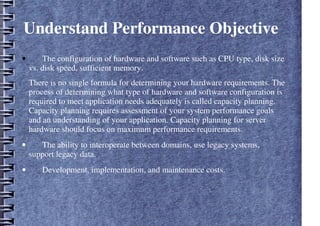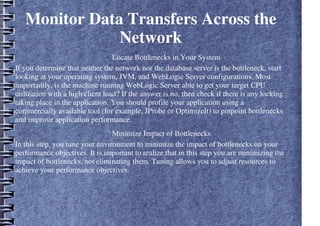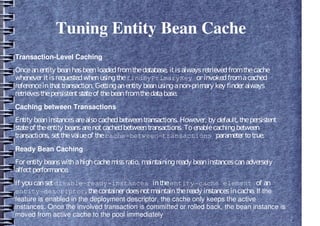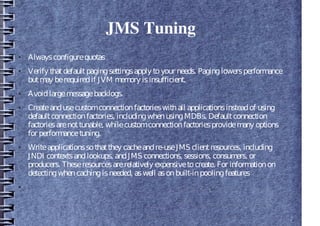Weblogic Cluster advanced performance tuning
- 1. Performance Tuning in Weblogic Server
- 2. Performance Tuning Topics ● Tuning EJB ● Tuning JMS ● Tuning Web Application ● Tuning Web Services ● Tuning JDBC ● Tuning Server
- 3. Understand Your Performance Objectives To determine your performance objectives, you need to understand the application deployed and the environmental constraints placed on the system. Gather information about the levels of activity that components of the application are expected to meet, such as: • The anticipated number of users. • The number and size of requests. • The amount of data and its consistency. • Determining your target CPU utilization. Your target CPU usage should not be 100%, you should determine a target CPU utilization based on your application needs, including CPU cycles for peak usage. If your CPU utilization is optimized at 100% during normal load hours, you have no capacity to handle a peak load. In applications that are latency sensitive and maintaining the ability for a fast response time is important, high CPU usage (approaching 100% utilization) can reduce response times while throughput stays constant or even increases because of work queuing up in the server. For such applications, a 70% - 80% CPU utilization recommended. A good target for non-
- 4. Understand Performance Objective • The configuration of hardware and software such as CPU type, disk size vs. disk speed, sufficient memory. There is no single formula for determining your hardware requirements. The process of determining what type of hardware and software configuration is required to meet application needs adequately is called capacity planning. Capacity planning requires assessment of your system performance goals and an understanding of your application. Capacity planning for server hardware should focus on maximum performance requirements. • The ability to interoperate between domains, use legacy systems, support legacy data. • Development, implementation, and maintenance costs.
- 5. Monitor Utilization – Monitor Disk and CPU Utilization Run your application under a high load while monitoring the: • Application server (disk and CPU utilization) • Database server (disk and CPU utilization) The goal is to get to a point where the application server achieves your target CPU utilization. If you find that the application server CPU is under utilized, confirm whether the database is bottle necked. If the database CPU is 100 percent utilized, then check your application SQL calls query plans. For example, are your SQL calls using indexes or doing linear searches? Also, confirm whether there are too many ORDER BY clauses used in your application that are affecting the database CPU. If you discover that the database disk is the bottleneck (for example, if the disk is 100 percent utilized), try moving to faster disks or to a RAID (redundant array of independent disks) configuration, assuming the application is not doing more writes then required.
- 6. Monitor Utilization – Monitor Disk and CPU Utilization . Once you know the database server is not the bottleneck, determine whether the application server disk is the bottleneck. Some of the disk bottlenecks for application server disks are: • Persistent Store writes • Transaction logging (tlogs) • HTTP logging • Server logging The disk I/O on an application server can be optimized using faster disks or RAID, disabling synchronous JMS writes, using JTA direct writes for tlogs, or increasing the HTTP log buffer.
- 7. Monitor Data Transfers Across the Network – Locate Bottlenecks in Your System If you determine that neither the network nor the database server is the bottleneck, start looking at your operating system, JVM, and WebLogic Server configurations. Most importantly, is the machine running WebLogic Server able to get your target CPU utilization with a high client load? If the answer is no, then check if there is any locking taking place in the application. You should profile your application using a commercially available tool (for example, JProbe or OptimizeIt) to pinpoint bottlenecks and improve application performance. – Minimize Impact of Bottlenecks In this step, you tune your environment to minimize the impact of bottlenecks on your performance objectives. It is important to realize that in this step you are minimizing the impact of bottlenecks, not eliminating them. Tuning allows you to adjust resources to achieve your performance objectives.
- 8. EJB Tuning ■Deploymentdescriptorsareschema-based. Descriptorsthatarenew inthisreleaseof WebLogicServer arenotavailableasDTD-baseddescriptors. ■Avoidusingthe RequiresNew transactionparameter. UsingRequiresNew causestheEJB container to startanew transactionafter suspendingany currenttransactions. Thismeansadditional resources, includingaseparatedatabaseconnectionareallocated. ■Uselocal-interfacesor setcall-by-referencetotruetoavoidtheoverheadof serializationwhenoneEJB callsanother or anEJB iscalledby aservlet/JSP inthesame application. Notethefollowing: – Inreleaseprior toWebLogicServer 8.1, call-by-referenceisturnedonby default. For releasesof WebLogicServer 8.1andhigher, call-by-referenceisturnedoff by default. Older applicationsmigratingtoWebLogicServer 8.1andhigher thatdonotexplicitly turnoncall-by-referencemay experienceadropinperformance. – Thisoptimizationdoesnotapply tocallsacrossdifferentapplications.
- 9. EJB Tuning ■UseStatelesssessionbeansover Stateful sessionbeanswhenever possible. Stateless sessionbeansscalebetter thanstateful sessionbeansbecausethereisnostate informationtobemaintained. ■WebLogicServer providesadditional transactionperformancebenefitsfor EJBsthat resideinaWebLogicServer cluster. WhenasingletransactionusesmultipleEJBs, WebLogicServer attemptstouseEJB instancesfromasingleWebLogicServer instance, rather thanusingEJBsfromdifferentservers. Thisapproachminimizes network trafficfor thetransaction. Insomecases, atransactioncanuseEJBsthatreside onmultipleWebLogicServer instancesinacluster. Thiscanoccur inheterogeneous clusters, whereall EJBshavenotbeendeployedtoall WebLogicServer instances. In thesecases, WebLogicServer usesamultitier connectiontoaccessthedatastore, rather thanmultipledirectconnections. Thisapproachusesfewer resources, andyieldsbetter performancefor thetransaction. However, for bestperformance, thecluster shouldbe homogeneous — all EJBsshouldresideonall availableWebLogicServer instances.
- 10. Tuning Stateful Session Bean Cache TheEJB Container cachesstateful sessionbeansinmemory uptoacount specifiedby themax-beans-in-cache parameter specifiedin weblogic-ejb-jar.xml. Thisparameter shouldbesetequal tothenumber of concurrentusers. Thisensuresminimumpassivationof stateful sessionbeans todisk andsubsequentactivationfromdisk whichyieldsbetter performance.
- 11. Tuning Entity Bean Cache Transaction-Level Caching Onceanentity beanhasbeenloadedfromthedatabase, itisalwaysretrievedfromthecache whenever itisrequestedwhenusingthefindByPrimaryKey or invokedfromacached referenceinthattransaction. Gettinganentity beanusinganon-primary key finder always retrievesthepersistentstateof thebeanfromthedatabase. Caching between Transactions Entity beaninstancesarealsocachedbetweentransactions. However, by default, thepersistent stateof theentity beansarenotcachedbetweentransactions. Toenablecachingbetween transactions, setthevalueof thecache-between-transactions parameter totrue. Ready Bean Caching For entity beanswithahighcachemissratio, maintainingready beaninstancescanadversely affectperformance. If youcansetdisable-ready-instances intheentity-cache element of an entity-descriptor, thecontainer doesnotmaintaintheready instancesincache. If the feature is enabled in the deployment descriptor, the cache only keeps the active instances. Once the involved transaction is committed or rolled back, the bean instance is moved from active cache to the pool immediately
- 12. MDB Pool Tuning Thelifecycleof MDBsisvery similar tostatelesssessionbeans. TheMDB pool hasthesametuningparametersasstatelesssessionbeansandthesamefactors apply whentuningthem. Ingeneral, mostuserswill findthatthedefaultvalues areadequatefor mostapplications.
- 13. Tuning Stateless Session Bean Pool TheEJB container maintainsapool of statelesssessionbeanstoavoidcreatingand destroyinginstances. Thoughgenerally useful, thispoolingisevenmoreimportantfor performancewhentheejbCreate() andthesetSessionContext() methods areexpensive. Thepool hasalower aswell asanupper bound. Theupper boundisthe moreimportantof thetwo. Theupper boundisspecifiedby themax-beans-in-free-pool parameter. It shouldbesetequal tothenumber of threadsexpectedtoinvoketheEJB concurrently. Usingtoosmall of avalueimpactsconcurrency. Thelower boundisspecifiedby theinitial-beans-in-free-pool parameter. Increasingthevalueof initial-beans-in-free-pool increasesthe timeittakestodeploy theapplicationcontainingtheEJB andcontributestostartuptime for theserver. Theadvantageisthecostof creatingEJB instancesisnotincurredatrun time. Settingthisvaluetoohighwastesmemory.
- 14. Tuning Entity Bean Pool Theentity beanpool servestwopurposes: A targetobjectsfor invocationof findersviareflection. A pool of beaninstancesthecontainer canrecruitif itcannotfindaninstance for aparticular primary key inthecache. Theentity pool containsanonymousinstances(instancesthatdonothavea primary key). Thesebeansarenotyetactive(meaningejbActivate() has notbeeninvokedonthemyet), thoughtheEJB contexthasbeenset. Entity bean instancesevictedfromtheentity cachearepassivatedandputintothepool. The tunablesaretheinitial-beans-in-free-pool andmax-beans-in- free-pool. UnlikestatelesssessionbeansandMDBs, themax-beans-in- free-pool hasnorelationwiththethreadcount. Youshouldincreasethe valueof max-beans-in-free-pool if theentity beanconstructor or setEnityContext() methodsareexpensive.
- 15. JMS Tuning ● Alwaysconfigurequotas ● Verify thatdefaultpagingsettingsapply toyour needs. Paginglowersperformance butmay berequiredif JVM memory isinsufficient. ● Avoidlargemessagebacklogs. ● Createandusecustomconnectionfactorieswithall applicationsinsteadof using defaultconnectionfactories, includingwhenusingMDBs. Defaultconnection factoriesarenottunable, whilecustomconnectionfactoriesprovidemany options for performancetuning. ● Writeapplicationssothatthey cacheandre-useJMS clientresources, including JNDI contextsandlookups, andJMS connections, sessions, consumers, or producers. Theseresourcesarerelatively expensivetocreate. For informationon detectingwhencachingisneeded, aswell asonbuilt-inpoolingfeatures ●
- 16. JMS Tuning ● For asynchronousconsumersandMDBs, tuneMessagesMaximum onthe connectionfactory. IncreasingMessagesMaximum canimproveperformance, decreasingMessagesMaximum toitsminimumvaluecanlower performance, but helpsensurethatmessagesdonotendupwaitingfor aconsumer that'salready processingamessage. ● Avoidsinglethreadedprocessingwhenpossible. Usemultipleconcurrentproducers andconsumersandensurethatenoughthreadsareavailabletoservicethem. ● Tuneserver-sideapplicationssothatthey haveenoughinstances. Consider creating dedicatedthreadpoolsfor theseapplications. ● For client-sideapplicationswithasynchronousconsumers, tuneclient-sidethread pools ● Inparticular, it'snormally bestfor multipleJMS servers, destinations, andother servicestosharethesamestoresothatthestorecanaggregateconcurrentrequests intosinglephysical I/O requests, andtoreducethechancethataJTA transaction spansmorethanonestore. Multiplestoresshouldonly beconsideredonceit'sbeen establishedthattheasinglestoreisnotscalingtohandlethecurrentload.
- 17. Tuning Web Application Disable Page Checks Youcanimproveperformanceby disablingservletandJDP pagechecks. Seteachof the followingparametersto-1: pageCheckSeconds servlet-reload-check-secs servlet Reload Check Thesearedefaultvaluesfor productionmode. Use Custom JSP Tags OracleprovidesthreespecializedJSP tagsthatyoucanuseinyour JSP pages: cache, repeat, andprocess. Thesetagsarepackagedinataglibrary jar filecalledweblogic- tags.jar. Thisjar filecontainsclassesfor thetagsandataglibrary descriptor (TLD). Tousethesetags, youcopy thisjar filetotheWebapplicationthatcontainsyour JSPs andreferencethetaglibrary inyour JSP
- 18. Tuning Web Application Precompile JSPs YoucanconfigureWebLogicServer toprecompileyour JSPswhenaWebApplicationisdeployedor re- deployedor whenWebLogicServer startsupby settingtheprecompileparameter totrueinthejsp- descriptor elementof theweblogic.xml deploymentdescriptor. Toavoidrecompilingyour JSPs eachtimetheserver restartsandwhenyoutargetadditional servers, precompilethemusingweblogic.jspc andplacethemintheWEB-INF/classesfolder andarchivethemina.war file. Keepingyour sourcefilesina separatedirectory fromthearchived.war fileeliminatesthepossibility of errorscausedbyaJSP havinga dependency ononeof theclassfiles. Disable Access Logging Settingtheaccess-logging-disabled elementcaneliminateaccessloggingof theunderlying Web application, which can improve server throughput by reducing the loggingoverhead. Seecontainer- descriptor inDevelopingWebApplications, Servlets, and JSPs for Oracle WebLogic Server. Use HTML Template Compression Usingthecompress-html-template elementcompressestheHTML intheJSP template blocks which can improve runtime performance. If the JSP's HTML template block containsthe<pre> HTML tag, donotenablethisfeature. Seejsp-descriptor inDevelopingWebApplications, Servlets, andJSPsfor OracleWebLogic Server.
- 19. Tuning Web Services DesignWebServiceapplicationsfor course-grainedservicewithmoderate sizepayloads. ■Choosecorrectservice-style& encodingfor your wepserviceapplication. ■Control serializer overheadsandnamespacesdeclarationstoachievebetter performance. ■UseMTOM/XOP or FastInfosettooptimizingtheformatof aSOAP message. ■Carefully designSOAP attachmentsandsecurity implementationsfor minimumperformanceoverheads.
- 20. Tuning Web Services ■Consider usinganasynchronousmessagingmodel for applicationswith: – Slow andunreliabletransport. – Complex andlong-runningprocess. ■For transactional ServiceOrientedArchitectures(SOA) consider usingtheLastLogging Resourcetransactionoptimization(LLR) toimproveperformance. ■Usereplicationandcachingof dataandschemadefinitionstoimproveperformanceby minimizingnetwork overhead. ■Consider any XML compressiontechniqueonly whenXML compression/decompression overheadsarelessthannetwork overheadsinvolved. ■Applicationsthatareheavy usersof XML functionality (parsers) may encounter performance issuesor runoutof filedescriptors. Thismay occur becauseXML parser instancesare bootstrappedby doingalookupinthejaxp.propertiesfile(JAXP API). Oraclerecommendssetting thepropertiesonthecommandlinetoavoidunnecessary fileoperationsatruntimeandimprove performanceandresourceusage.
- 21. Tuning Heavily Loaded Systems to Improve Web Service Performance Setting the Buffering Sessions ThereliablemessagingandbufferingfeaturesuseJMS queuesessionstosend messagestothereliability/buffer queues. By default, WebLogicServer allocates 10sessionsfor bufferingwhichenables10clientstoenqueuemessages simultaneously ontothereliability/buffer queue. For asynchronousrequest-response, therequestandresponseportionof the communicationexchangecountseparately, astwoclients. Inthiscase, the defaultpool of sessionscansupportfivesimultaneousasynchronousrequest- responseclients. Toaccommodatethenumber of concurrentclientsyouexpect inyour application, setthefollowingparameter totwicethenumber of expected clientthreads: -Dweblogic.wsee.buffer.QueueSessionPoolSize=size
- 22. Tuning Heavily Loaded Systems to Improve Web Service Performance Releasing Asynchronous Resources Whenusingtheasynchronousrequest-responsefeature, WebLogicServer persistently storesinformationabouttherequestuntil theasynchronousresponseisreturnedtothe client. Theseresourcesremaininthepersistentstoreuntil they arereleasedby a backgroundthread, calledthestore cleaner. Often, theseresourcescanbereleasedsooner. Executingthestorecleaner more frequently canhelptoreducethesizeof thepersistentstoreandminimizethetime requiredtocleanit. By default, thestorecleaner runsevery twominutes(120000ms). Oraclerecommendsthatyousetthestorecleaner interval tooneminute(60000ms) usingthefollowing Javasystemproperty: -Dweblogic.wsee.StateCleanInterval=60000






















